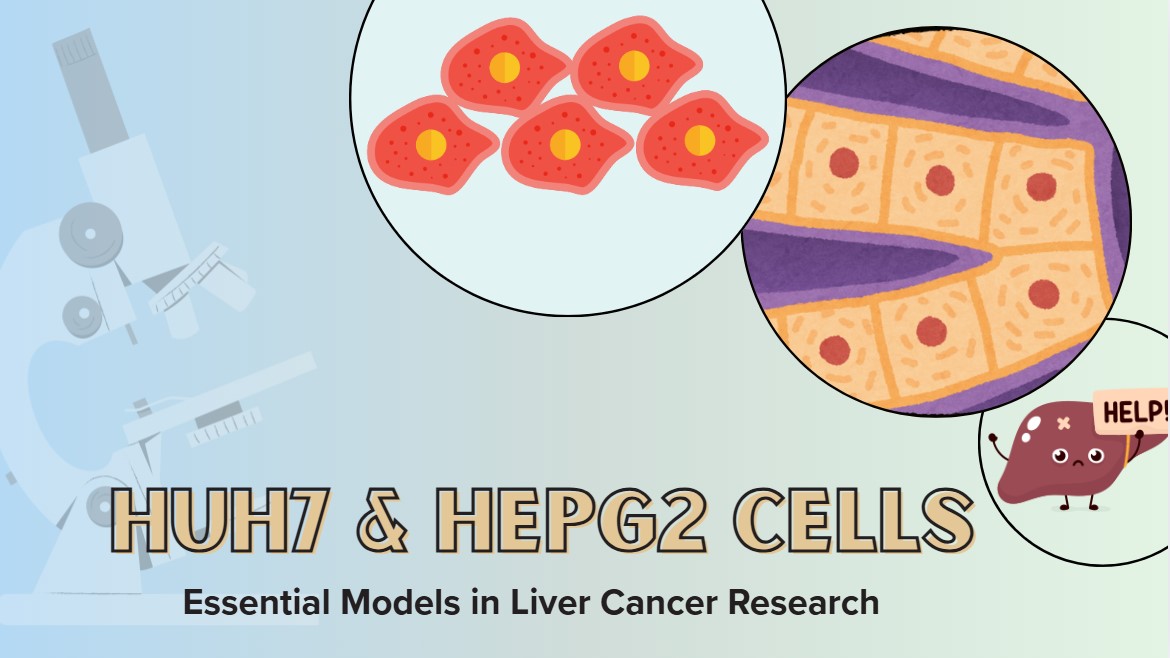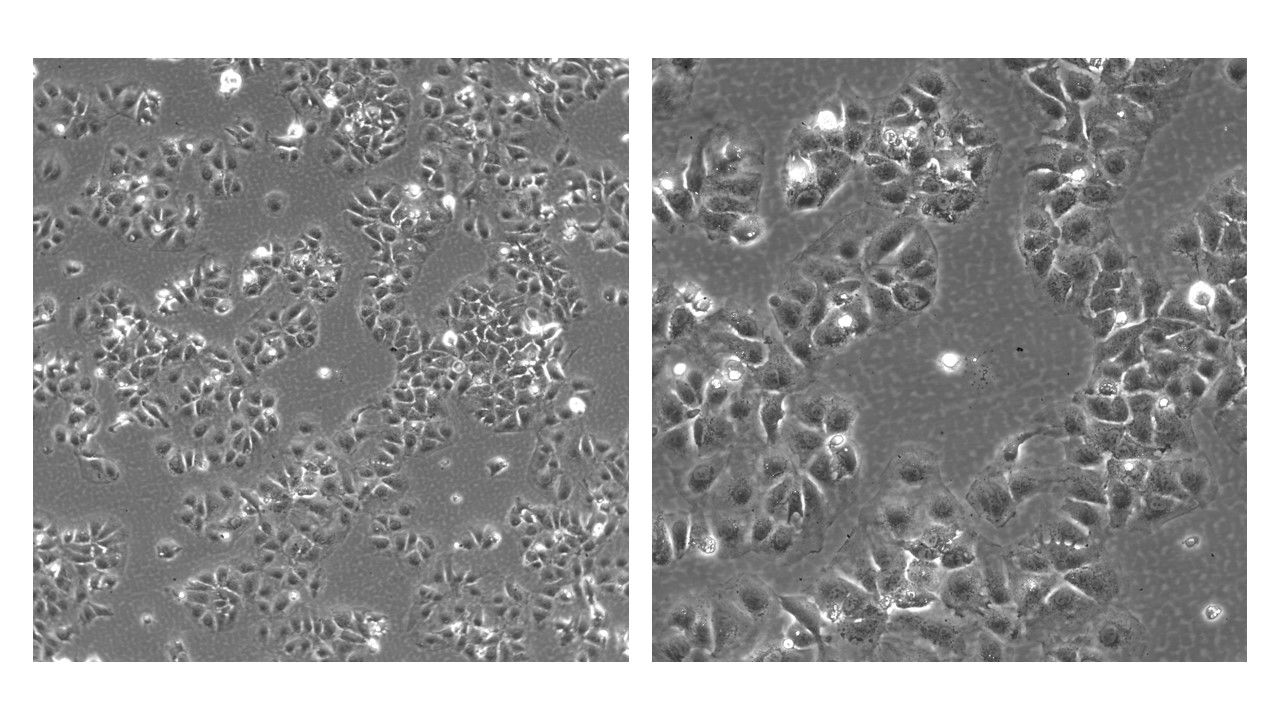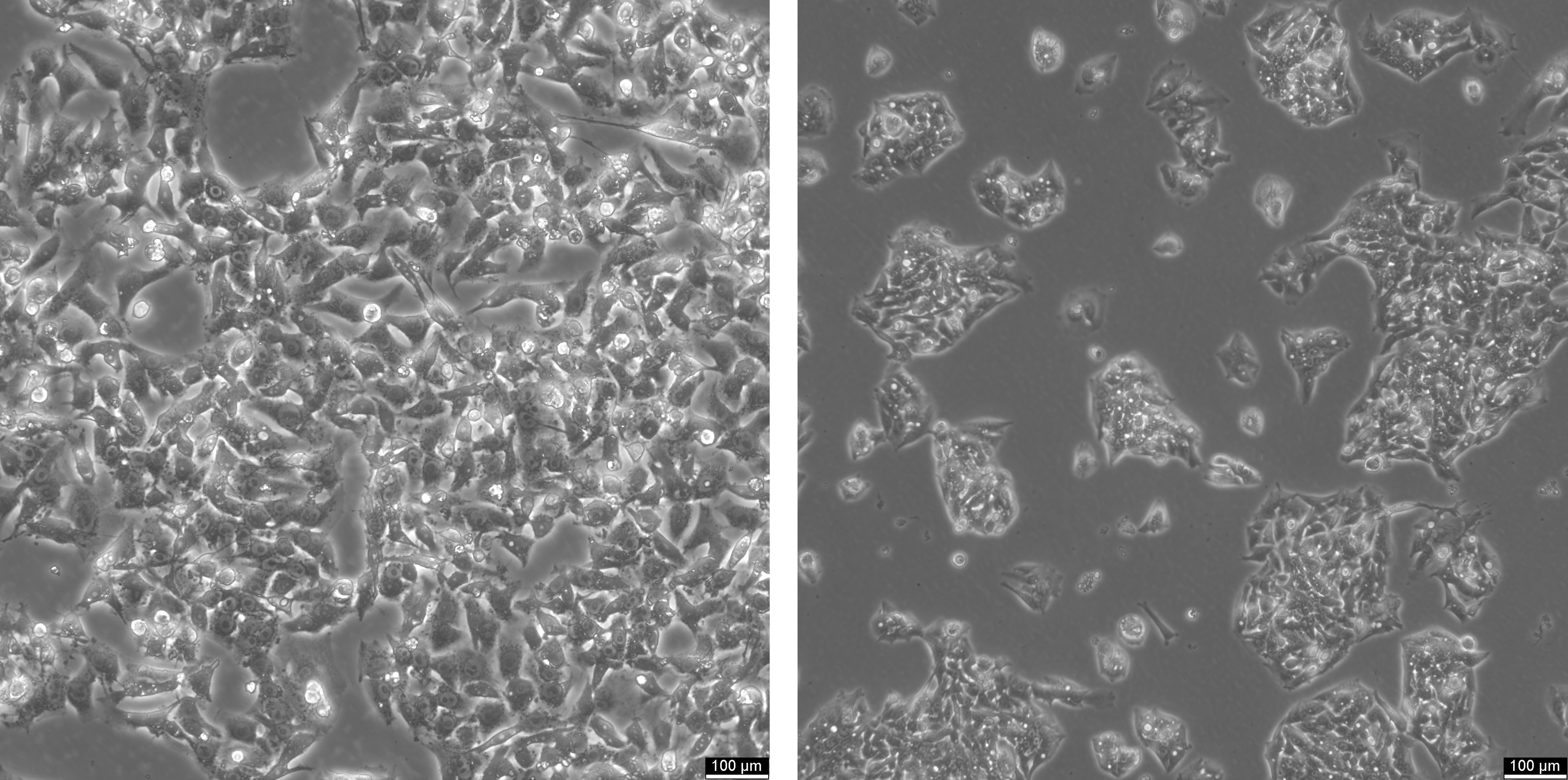HuH7 and HepG2 Cells: Essential Models in Liver Cancer Research
Published On 07/23/2025 2:40 PM

Understanding HuH7 & HepG2 Cell Lines: Essential Models in Liver Cancer Research
Liver cancer, especially hepatocellular carcinoma (HCC), remains a devastating disease with low survival rates due to late-stage diagnosis and limited effective therapies. To propel breakthroughs, researchers rely heavily on immortalized liver cancer cell lines—among them, Huh7 and HepG2. These two models play starring roles in deciphering liver cancer biology and testing new treatments.
1.The Significance of Huh7 and HepG2 Cell Lines in Liver Cancer Research
Liver cancer cell lines, such as HuH7 and HepG2 are immortalized cell cultures derived from human liver tumor tissues. These cell lines serve as practical surrogate for primary hepatocytes in vitro and therefore enable researchers to conduct controlled experiments such as testing drug efficacy and identifying potential theraprutic targets. They are also essential in the study of viral infections, demonstrating complete cell cycle replication of hepatitis D (HDV) and expression of hepatitis B (HBV).
The HuH7 cell line, derived from human hepatoma, represents an immortalized collection of tumorigenic epithelial-like cells. It is predominantly utilized in cell culture models to investigate hepatitis C virus (HCV) infection and hepatoma pathophysiology. On the other hand, unlike HuH7, HepG2 cells are non-metastatic, but they are widely used in studies related to liver metabolism, drug testing, and a variety of liver dieseases.
2. HuH7 Cell Line: A Model for Hepatitis-C-Related Liver Cancer
Get HuH7 Cells (SKU: BHC11100002) For Your Scientific Breakthroughs >>
Origin and Characteristics of HuH7 Cells
The HuH7 cell line was established by Sato, J, and Nakabayshi, H in 1982, derived from a highly differentiated hepatocyte cancer lineage. It was originally sourced from hepatocellular carcinoma in a 57-year-old Japanese male. Characterized by its capacity to produce various physiologically relevant substances, such as albumin and alpha-fetoprotein, HuH7 cells exhibit a high susceptibility to HCV infection, making them suitable for use in HCV replicon systems. This feature renders the cell line valuable for the screening and development of anti-HCV therapeutics. HuH7 cells display an epithelial-like morphology, with a hexagonal shape, and adhere to surfaces to form 2D monolayers during growth. On average, HuH7 cells have a diameter of 21.9µm, tending towards a larger, flattened appearance. The HuH7 cell line is characterized by a heterogeneous chromosome number, typically ranging between 55 and 63, which reflects the genetic variability within the cell population. This heterogeneity is a consequence of selective pressures encountered during cell culture, and may vary across different laboratory conditions.

Fig 1. HuH7 cells at 10x and 20x magnification.
Advantages of HuH7 cell line
HuH7 cells possess many characteristic features that make them attractive for research use.• Easy propagation: Unlike other human hepatoma cell lines, the HuH7 cell line can be grown without the addition of serum easily; however, CLS recommends using RPMI 1640 with 10% FBS and 2 mM L-glutamine. HuH-7 cells secrete a growth factor that helps cells
grow without serum.
• Transfection flexibility: The HuH7 cell line is widely used for transfection purposes due to its high receptiveness to the HCV genome. Therefore, these cells are pivotal for anti-HCV drug screening and development.
• Alternative to human hepatocytes: The HuH7 cell line is an excellent substitute for human hepatocytes. It can help researchers study hepatic drug transporters and understand the interaction of certain drugs with MRPs (multi-drug resistance-associated proteins).
• Developing a xenograft mouse model: HuH7 cells have been used to produce a cell line-originated xenograft mouse model. This animal model may provide valuable insights for researchers about protein kinase inhibitors and anti-cancer therapies.
• Cancer research: The HuH7 cell line is a human liver cancer cell line, which helps researchers conduct liver cancer studies.
grow without serum.
• Transfection flexibility: The HuH7 cell line is widely used for transfection purposes due to its high receptiveness to the HCV genome. Therefore, these cells are pivotal for anti-HCV drug screening and development.
• Alternative to human hepatocytes: The HuH7 cell line is an excellent substitute for human hepatocytes. It can help researchers study hepatic drug transporters and understand the interaction of certain drugs with MRPs (multi-drug resistance-associated proteins).
• Developing a xenograft mouse model: HuH7 cells have been used to produce a cell line-originated xenograft mouse model. This animal model may provide valuable insights for researchers about protein kinase inhibitors and anti-cancer therapies.
• Cancer research: The HuH7 cell line is a human liver cancer cell line, which helps researchers conduct liver cancer studies.
Limitations of the HuH-7 cell line
There are some limitations associated with the culturing of the HuH7 cell line.
• Microbial contamination: Bacterial contamination is the most common problem in cell culture. When an infection happens, it can be distinguished through the pH change and turbidity of the culture medium. Among bacterial contamination, mycoplasma contamination is usually not apparent. However, it slowly affects the morphology, gene expression, and other characteristics of the cell line.
• Culture period: Although the HuH7 cell line is immortal, exceeding the culture period can affect the health of cells gradually. It may affect the proliferation rate and gene expression, which may reduce the reproducibility of results. For the HuH7 cell line, the passage number should be kept below 20–25.
Applications of HuH-7 cells
This human hepatoma-derived cell line offers many research applications. Here we are describing a few research areas using the HuH7 cell line.
Drug resistance: HuH7 is a hepatocellular carcinoma (HCC) cell line that can be used to study drug resistance against potential liver cancer treatments. A study conducted in 2021 used HuH7 cells, which were experimentally made resistant to sorafenib, to develop new and effective therapeutics, i.e., mitochondria-accumulating self-assembly peptides.
Genetic Insights and Molecular Profiling Through HuH7 Cells: The distinct HuH7 cell lines, including various derivatives and variants, have enabled a deeper understanding of gene expression and the role of specific genomic markers in disease. Techniques such as Raman spectroscopy, championed by researchers like Evgeny Gladilin, have been applied to HuH7 cells for molecular and cellular profiling, revealing insights into the cellular response to viral infection. The potential of Raman spectroscopy, combined with methods like quantitative proteomics, has facilitated the exploration of host cell responses, including the interferon response and changes in lipid droplets, which are critical for understanding HCV replication and the effect of SARS. The expression of different oncogenic markers can be investigated to understand their behavior in response to any treatment, such as in a study that used HuH7 cells to investigate the effect of the Kaempferol compound on the expression pattern of MMP9 and AKT pathway genes. These pathways regulate the metastasis and invasiveness of hepatocellular carcinoma. Another recent study also investigated the role of the Wnt/β-catenin signaling cascade gene in the survival and growth of HCC cells.
Drug development: HuH7 cells are widely used in drug screening and development studies against liver cancer. Multiple studies have been conducted to investigate the inhibitory potential of many plant extracts, plant-based compounds, nanoparticles, and other therapeutic agents against HCC. A study conducted in 2022 studied the pro-apoptotic and anti-cancer properties of a radionuclide against hepatocellular carcinoma using a HuH7 cell line.
Viral Research and Cellular Analysis: HuH7 cells have become a cornerstone in the study of viral infection and infectious diseases, particularly hepatitis C virus (HCV) and their interactions with coronaviruses like SARS-CoV-2, responsible for coronavirus disease 2019 (COVID-19). The development of experimental HCV cell culture systems (HCVcc) using HuH7 cells has significantly advanced our ability to study HCV's intricate replication process and host factors essential for HCV infection. This includes examining the efficiency of HCV RNA replication and the production of infectious virions. The distinct lines of HuH7 cells, including senescent and infected variants, provide a diverse panel for investigating the multiplicity of infection, viral propagation, and inhibition mechanisms against viruses like SARS.
Get HuH7 Cells For Your Scientific Breakthroughs >> (SKU: BHC11100002)
Drug resistance: HuH7 is a hepatocellular carcinoma (HCC) cell line that can be used to study drug resistance against potential liver cancer treatments. A study conducted in 2021 used HuH7 cells, which were experimentally made resistant to sorafenib, to develop new and effective therapeutics, i.e., mitochondria-accumulating self-assembly peptides.
Genetic Insights and Molecular Profiling Through HuH7 Cells: The distinct HuH7 cell lines, including various derivatives and variants, have enabled a deeper understanding of gene expression and the role of specific genomic markers in disease. Techniques such as Raman spectroscopy, championed by researchers like Evgeny Gladilin, have been applied to HuH7 cells for molecular and cellular profiling, revealing insights into the cellular response to viral infection. The potential of Raman spectroscopy, combined with methods like quantitative proteomics, has facilitated the exploration of host cell responses, including the interferon response and changes in lipid droplets, which are critical for understanding HCV replication and the effect of SARS. The expression of different oncogenic markers can be investigated to understand their behavior in response to any treatment, such as in a study that used HuH7 cells to investigate the effect of the Kaempferol compound on the expression pattern of MMP9 and AKT pathway genes. These pathways regulate the metastasis and invasiveness of hepatocellular carcinoma. Another recent study also investigated the role of the Wnt/β-catenin signaling cascade gene in the survival and growth of HCC cells.
Drug development: HuH7 cells are widely used in drug screening and development studies against liver cancer. Multiple studies have been conducted to investigate the inhibitory potential of many plant extracts, plant-based compounds, nanoparticles, and other therapeutic agents against HCC. A study conducted in 2022 studied the pro-apoptotic and anti-cancer properties of a radionuclide against hepatocellular carcinoma using a HuH7 cell line.
Viral Research and Cellular Analysis: HuH7 cells have become a cornerstone in the study of viral infection and infectious diseases, particularly hepatitis C virus (HCV) and their interactions with coronaviruses like SARS-CoV-2, responsible for coronavirus disease 2019 (COVID-19). The development of experimental HCV cell culture systems (HCVcc) using HuH7 cells has significantly advanced our ability to study HCV's intricate replication process and host factors essential for HCV infection. This includes examining the efficiency of HCV RNA replication and the production of infectious virions. The distinct lines of HuH7 cells, including senescent and infected variants, provide a diverse panel for investigating the multiplicity of infection, viral propagation, and inhibition mechanisms against viruses like SARS.
Get HuH7 Cells For Your Scientific Breakthroughs >> (SKU: BHC11100002)
3. HepG2 Cells: A Robust Model for Liver Metabolism & General HCC Modeling
Get HepG2 Cells (SKU: BHC11100234) >>HepG2 cells, originating from human hepatoma, have become an invaluable tool for researching liver functions and diseases, including hepatocellular carcinoma. Being the first hepatic cell line to exhibit the critical characteristics of hepatocytes, HepG2 cell line provides insights into the cellular responses of human hepatocytes under various experimental conditions. The use of luciferase reporter plasmids in HepG2 cells has been particularly effective for tracking gene expression and cellular transfections, which are fundamental in metabolic research, such as the study of ethanol's effects on liver cells. HepG2 cells are also employed to investigate a variety of human liver diseases, from genetic conditions like progressive familial intrahepatic cholestasis (PFIC) and Dubin-Johnson Syndrome to environmental and dietary studies related to cytotoxic and genotoxic agents, as well as in drug targeting and hepatocarcinogenesis research.
Origin and Characteristics of HepG2 Cells
Hep-G2 is a human liver cancer cell line originating from the liver tissue of a 15-year-old Caucasian male with hepatocellular carcinoma. Initially mistaken as hepatocellular carcinoma, these cells were first isolated in 1975 and later recognized as hepatoblastoma rather than hepatocellular carcinoma, resolving years of confusion. These cells are frequently utilized in drug metabolism and hepatotoxicity studies. Although HepG2 cells have high proliferation rates and an epithelial-like appearance, they are non-tumorigenic and perform various differentiated hepatic functions. HepG2 cells can secrete various plasma proteins and provide a valuable model for studying the intracellular dynamics of cell surface domains in human hepatocytes.Cytologically, HepG2 cells have an average diameter of 10-20 micrometres, large nuclei with 3-7 nucleoli, and low mitochondrial content. They exhibit specific chromosomal abnormalities associated with hepatoblastomas, such as translocations and trisomies. Furthermore, these cells carry a TERT promoter mutation (C228T) and maintain wild-type TP53, essential in cancer development.HepG2 cells differ from normal hepatocytes regarding cytochrome P450 (CYP) enzyme expression. They have a weak or absent expression of several CYP enzymes involved in xenobiotic metabolism in the liver. This distinction should be considered when using HepG2 cells to predict xenobiotic metabolism and elimination.Despite these limitations, HepG2 cells have been utilized in studying drug metabolism and toxicity testing. They exhibit similarities in the expression of drug metabolism/transport proteins in hepatocellular carcinoma and hepatoblastoma cells. Efforts are underway to enhance the expression of cytochromes in HepG2 cells, making them a more reliable model for hepatocyte research. Three-dimensional spheroid cultures are also being explored to create a more physiologically relevant system, as these models exhibit higher metabolic activity than traditional 2D cell cultures.

Fig 2. HepG2 cells at High and Low Confluences.
Applications of HepG2 cells in liver disease research
Viral Infections and Liver Disease Studies: Immortalized hepatic tumor cell lines like HepG2 and Huh7 are essential in the study of viral infections, demonstrating complete cell cycle replication of hepatitis D (HDV) and expression of hepatitis B (HBV). In parallel, HepaRG cell lines play a critical role in elucidating HBV entry mechanisms. HepG2 cells are also employed to investigate a variety of human liver diseases, from genetic conditions like progressive familial intrahepatic cholestasis (PFIC) and Dubin-Johnson Syndrome to environmental and dietary studies related to cytotoxic and genotoxic agents, as well as in drug targeting and hepatocarcinogenesis research. Their use extends to trials with bio-artificial liver devices.Interactions of HepG2 Cells with Biomaterials in Tissue Engineering: The interaction of HepG2 cells with various biomaterials is pivotal in tissue engineering. Techniques such as the colloidal probe technique help understand these interactions by measuring cell adhesion properties, which are vital in determining cell viability for the development of scaffolds and accurate liver tissue models.
Cell Behavior and Innovations in HepG2-Based Models: Studying cell behavior in HepG2-based models is crucial for liver disease research. Advancements in three-dimensional spheroid cell cultures have led to the creation of HepG2 cell spheroids, offering a more physiologically relevant model that closely mirrors normal hepatocytes. These 3D models, with increased metabolic activity, are indicative of the potential for HepG2 cells to serve as a model for hepatoblastoma and are significant in cancer treatment research, especially for simulating liver tumors and testing novel therapeutic approaches.
Drug testing and toxicity studies: HepG2 cells are routinely used in the screening of hepatotoxic compounds and the evaluation of drug metabolism. Their ability to mimic certain liver functions makes them a valuable tool for drug testing, especially for compounds targeting liver cancer or liver fibrosis.
Get HepG2 Cell Line (SKU: BHC11100234) >>
4. Comparative Analysis: HuH7 vs. HepG2
| Feature | HuH7 | HepG2 |
| Origin | HCC from 57‑year‑old male (Japan) | HCC from 15‑year‑old male (Argentinian) |
| Metastatic Potential | Moderate | Non-metastatic |
| Virus Replication | Supports HCV | Does not support HCV |
| Liver Functions | Basic metabolic activity | Strong hepatocyte-like functions (albumin, CYP, urea) |
| Ideal Research Use | HCV‑linked cancer, antivirals, immune studies | Drug metabolism, toxicity testing, basic cancer biology |
This entry was posted in
Product Literature
,Application and Technique Notes
 Loading ....
Loading ....
